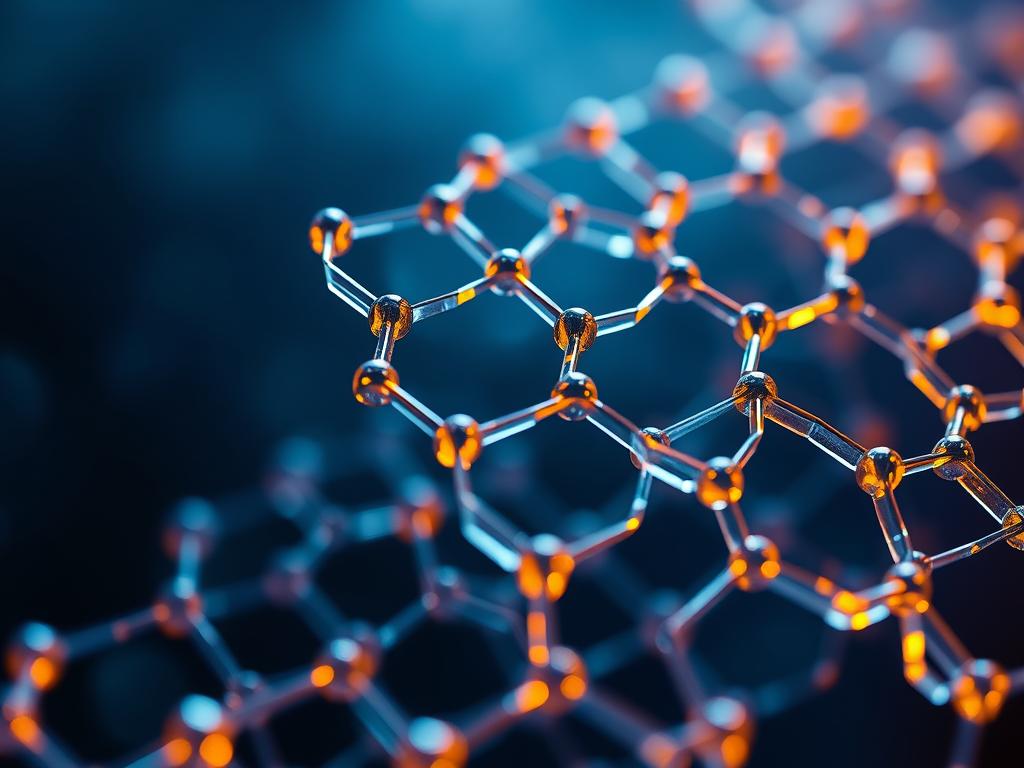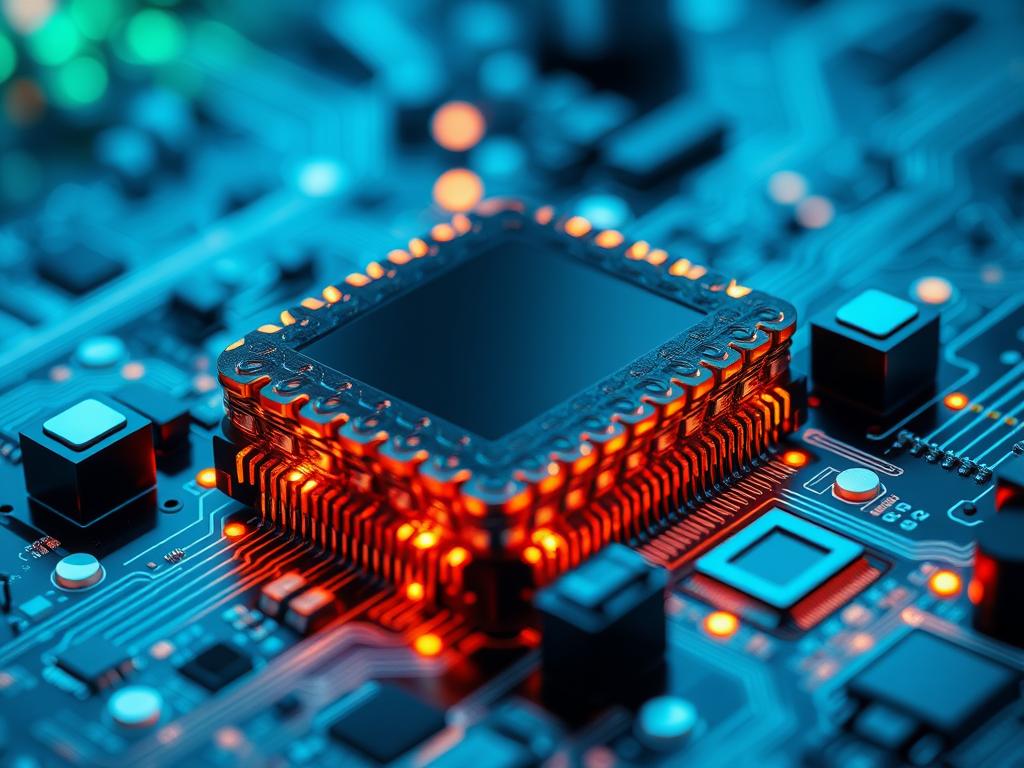Graphene transistors are a big leap in electronics, promising speeds up to 1000 times faster than silicon. They are made from a single layer of carbon atoms in a honeycomb shape. This design makes them super good at conducting electricity and heat.
Graphene’s special properties could lead to transistors that work at terahertz speeds. This could change the game for gadgets, communication, and green energy. But, there are hurdles to overcome before they can be used everywhere.
These challenges include making them on a large scale, ensuring high quality, and fitting them into current tech. It’s a tough road ahead, but with teamwork, we can get there.
Key Takeaways
- Graphene transistors offer exceptional speed and energy efficiency compared to silicon transistors.
- Potential applications include faster data processing, improved communication networks, and enhanced computational tasks.
- Challenges include manufacturing scalability, material quality, and integration with existing technologies.
- Collaboration between researchers, engineers, and industry leaders is crucial for successful implementation.
- Graphene-based transistors can operate at higher frequencies, making them suitable for high-speed applications.
Introduction to Graphene Transistors
Graphene is a groundbreaking carbon material that has caught the attention of the electronics world. Graphene transistors use its unique properties to improve computing and transistor technology. They are a big step forward in making devices more efficient and using less power.
What Are Graphene Transistors?
Graphene transistors are made from a single layer of carbon atoms in a honeycomb shape. They outperform traditional silicon devices in speed, power use, and efficiency at room temperature. This makes them a key player in the future of electronics.
Brief History of Graphene Research
Graphene research began in 2004, earning a Nobel Prize in Physics in 2010. Since then, scientists have been studying its uses, including in transistors. Its high electrical and thermal conductivity, along with its strength, make it ideal for new electronic devices.
“Graphene has an electron mobility greater than 200,000 cm2/Vs at room temperature, which is over 100 times that of Silicon and 30 times that of GaAs.”
Graphene transistors have seen major progress, with ongoing research to fully exploit their benefits. As carbon-based semiconductors evolve, graphene transistors will be vital for the next generation of electronics and computing.
The Unique Properties of Graphene
Graphene is a two-dimensional material with amazing properties. It’s a game-changer in nanoelectronics and carbon-based semiconductors. Its electrical conductivity, thermal conductivity, and mechanical strength make it a key material for the future.
Exceptional Electrical Conductivity
Graphene conducts electricity 13 times better than copper. This means it can move charges fast, making transistors up to 1000 GHz. Its unique atomic structure helps electrons move efficiently.
High Thermal Conductivity
Graphene also conducts heat well, even better than diamond. This is great for keeping electronic devices cool. It helps devices work better and last longer.
Mechanical Strength and Flexibility
Graphene is incredibly strong, 200 times stronger than steel. Yet, it’s also very flexible, stretching up to 25% without breaking. This makes it perfect for durable, flexible electronics.

Graphene’s properties are truly remarkable. It’s a game-changer for electronics and semiconductors. As research grows, graphene will change the electronics world.
How Graphene Transistors Work
Graphene is a one-atom-thick carbon material that’s really good at conducting electricity. It’s better than silicon in many ways. This makes graphene transistors work better than the old silicon ones.
Basics of Semiconductor Technology
Modern electronics rely on semiconductors, and transistors are key. Silicon is often used because it can control electron flow well. An electric field helps switch and amplify signals.
Graphene’s Role in Transistor Functionality
Graphene’s special band structure helps it move electrons fast. This means graphene transistors can switch on and off quicker. They also conduct electricity better than silicon.
Graphene transistors work like regular ones but better. They’re faster and more efficient. This makes graphene a great choice for future electronics.
| Property | Graphene | Silicon |
|---|---|---|
| Electron Mobility | 150,000 cm²/Vs | 1,400 cm²/Vs |
| Operational Speed | Terahertz range | Gigahertz range |
| Thickness | 1 atom thick | Microns thick |
The table shows graphene’s amazing properties. It’s super thin and strong. This makes it perfect for advanced electronics.
“Graphene is the thinnest material possible, yet it is also one of the strongest. Its remarkable properties make it an ideal candidate for a wide range of applications, including next-generation semiconductor technology.”
Advantages of Graphene Transistors
Graphene transistors are changing the game in electronics. They are fast, energy-saving, and super small. This is because graphene is incredibly thin, strong, and good at carrying electricity.
Faster Switching Speeds
Graphene transistors switch on and off much faster than old silicon ones. They can go up to 100 times quicker. This is great for fast data and computing needs.
Reduced Power Consumption
These transistors also use less power. They can work with just 150 millivolts, compared to silicon’s 500 millivolts. This is good for saving energy in devices big and small.
Potential for Miniaturization
Graphene is so thin, it’s just one atom thick. This lets us make electronics much smaller. The smallest graphene transistor is only ten atoms wide. This opens up new possibilities for tiny devices.

“Graphene transistors offer a remarkable set of advantages that make them a game-changer in the world of high-speed computing, energy-efficient devices, and miniaturized nanoelectronics.”
Graphene transistors are in high demand. They are fast, save energy, and can be made very small. This makes them perfect for many uses, from quick computers to tiny medical devices.
Current Applications of Graphene Transistors
Graphene transistors are changing the game in many fields. They show great promise in future technologies. Their unique properties are being used to improve performance and drive innovation in electronics, consumer devices, telecommunications, and medicine.
Electronics and Consumer Devices
Graphene is perfect for next-generation electronics because of its great electrical conductivity. Graphene transistors can process information faster and use less power. This means we can have smaller, more efficient devices like smartphones and laptops.
Researchers are working on using graphene in many products. This includes wearable tech and IoT devices.
Telecommunications and Networking
Graphene transistors are great for high-speed data transmission. They could make networks faster and more reliable. Graphene devices can transfer data quicker and use less bandwidth. This could change how we communicate worldwide.
Medical Devices and Sensors
Graphene is also being used in medicine. Its properties are helping create new diagnostic and therapeutic tools. Graphene sensors are more accurate, making medical devices better for monitoring health and detecting diseases.
Graphene is also being used in implantable and wearable tech. This could lead to personalized healthcare solutions that fit right into our bodies.
As research on graphene transistors grows, we’ll see even more exciting uses. They will shape the future of future technology, research developments, and graphene applications.
“The versatility of graphene transistors is truly astounding, opening up new frontiers in electronics, communications, and healthcare. As we delve deeper into this revolutionary material, the possibilities for transforming our world seem limitless.”
Key Challenges Facing Graphene Transistors
Graphene transistors have great potential but face big challenges. One major issue is making large, high-quality graphene sheets. The complex making process is expensive, more so than silicon technology.
Another big problem is integrating graphene transistors with existing electronic systems. Silicon-based components dominate the industry. Adding graphene devices is a big tech challenge. Solving these scalability issues is key for graphene transistors to be widely used.
Scientists are trying to solve these problems. They’re using methods like chemical vapor deposition (CVD) and liquid exfoliation to make graphene better. They’re also working on new ways to connect graphene with silicon electronics.
Despite these hurdles, graphene’s special properties keep it interesting. It has fast electron movement, high heat transfer, and strong mechanical strength. These traits make graphene useful in many fields like electronics, energy, and medicine. As making and integrating graphene gets better, its future looks bright.

“Graphene has demonstrated a field-effect mobility (μFE) of 30,000 cm2/Vs in real device simulations.”
Advances in Graphene Fabrication Techniques
Creating efficient ways to make graphene is key for better graphene transistors. New methods have helped solve old problems in making high-quality graphene. Chemical vapor deposition (CVD) and liquid exfoliation are now top choices for making graphene.
Chemical Vapor Deposition (CVD)
CVD is a top method for making big, high-quality graphene films. It’s good for making lots of graphene for transistors. In CVD, carbon atoms from hydrocarbon precursors are deposited on a metal surface, like copper or nickel, to form graphene.
This method lets us control graphene’s thickness, defects, and doping levels. We can change these by tweaking temperature, pressure, and gas mix.
Liquid Exfoliation Methods
Liquid exfoliation is another way to make graphene, which might be cheaper and better. It breaks down graphite into graphene sheets using solvents or surfactants. Then, these sheets can be used in many ways, like in transistors.
Methods like ultrasonication and electrochemical exfoliation are improving graphene quality and scalability. They’re making graphene with fewer defects and better for large-scale use.
Improvements in making graphene are making transistors better and more reliable. By solving graphene synthesis challenges, we’re getting closer to using graphene in more devices.
| Fabrication Technique | Key Features | Advantages | Limitations |
|---|---|---|---|
| Chemical Vapor Deposition (CVD) |
|
|
|
| Liquid Exfoliation |
|
|
|
Graphene Transistors vs. Silicon Transistors
Graphene and silicon transistors have big differences in performance. Graphene transistors have electron mobility up to 200,000 cm²/Vs. This is much higher than silicon transistors’ 1,400 cm²/Vs.
Graphene transistors can work at frequencies over 100 GHz. Silicon transistors, on the other hand, can only reach 3-4 GHz. This makes graphene much faster.
Even though graphene is better, silicon transistors are cheaper to make. This is because silicon has well-known production methods. But graphene could lead to even smaller transistors in the future. This could be a big step forward, even if it costs more now.
| Metric | Graphene Transistors | Silicon Transistors |
|---|---|---|
| Electron Mobility | 200,000 cm²/Vs | 1,400 cm²/Vs |
| Operating Frequency | Over 100 GHz | 3-4 GHz |
| Manufacturing Costs | Higher | Lower |
| Miniaturization Potential | Sub-100 nm channel length | Established processes |
Graphene transistors have amazing properties like super-fast electron mobility. They also have the potential to be made very small. This makes them better than silicon transistors in many ways.
Even though making graphene transistors is more expensive, their benefits are huge. They could lead to faster and more efficient electronics in the future.

Future of Graphene Transistors
The future of graphene transistors looks bright. Scientists are working hard to improve them. They want to make them better at conducting electricity and easier to make in large amounts.
Experts think the demand for these transistors will grow fast. This is because people want electronics that work well and use less energy.
Potential Innovations and Breakthroughs
Scientists are finding new ways to make graphene transistors better. One big discovery is that bilayer graphene can have electric charges without needing an outside field. This is a big deal for how these transistors work.
Another breakthrough is “holey super graphene.” It’s made by Nanografi Nano Technology. It’s up to 3.3 times better at conducting electricity than regular graphene.
New ways to make graphene are also being developed. Companies like NanoXplore Inc. and Columbia University engineers are making it cheaper and better. This will help make graphene transistors more common in devices.
Market Projections and Research Trends
The market for graphene transistors is expected to grow a lot. This is because people want electronics that work well and use less energy. Researchers are looking into how to use graphene in new ways, like in quantum computers and AI.
Graphene is very strong and good at conducting electricity. It’s also great for other technologies. As scientists keep working, graphene transistors could change the electronics world a lot.
Graphene in Flexible Electronics
Graphene is changing the game in flexible electronics and wearable devices. Its flexibility, strength, and conductivity are unmatched. This makes it perfect for bendable displays, flexible sensors, and advanced wearable tech.
Wearable Technology Applications
Graphene is ideal for wearable tech. Its electrical properties can be tuned, and it’s very conductive. This allows for the creation of smart clothes, flexible sensors, and health monitors.
Challenges in Production and Scalability
Graphene’s potential in flexible electronics is huge, but there are manufacturing challenges. Keeping its properties during production is tough. Overcoming these manufacturing challenges is key to unlocking graphene’s full potential in flexible and wearable electronics.
| Key Graphene Properties for Flexible Electronics | Wearable Technology Applications | Manufacturing Challenges |
|---|---|---|
|
|
|

“Graphene’s flexibility and strength make it ideal for flexible electronics and wearable technology applications. However, challenges in production and scalability persist, limiting the widespread adoption of this revolutionary material.”
Environmental Impacts of Graphene Production
Graphene transistors are becoming more popular, but their production affects the environment. The methods used, like chemical vapor deposition (CVD) and liquid exfoliation, use a lot of energy. This can harm the planet. Scientists are looking for greener ways to make graphene to reduce its impact.
Sustainability Concerns
The demand for graphene is growing fast, with a 32% annual increase. Studies show that moving and changing graphene can be risky. It’s important to find ways to make graphene production safer for our planet.
Regulation and Safety Measures
As graphene transistors are used more, rules are being made to keep people safe. Scientists are working on standards and ways to handle graphene safely. Testing labs are key in checking graphene quality and making sure it works well with other materials.
Graphene production’s environmental effects are complex. But, by focusing on both technology and the environment, we can make a difference. This way, the industry can move towards a greener future.
“Graphene has the potential to revolutionize a wide range of industries, but we must ensure its production and use is done in an environmentally responsible manner.”
Graphene Transistors in Quantum Computing
The amazing features of graphene transistors have caught a lot of attention for quantum computing. Graphene is super good at carrying electricity, moves charges fast, and has a special electronic structure. These traits make it great for working with quantum states, key for making quantum computers work well.
Possibilities for Quantum Applications
Graphene transistors can work at super high speeds, up to 100 GHz. This is perfect for quantum computing, where fast control over quantum bits (qubits) is needed. Graphene’s special properties help it move charges well and keep quantum states stable.
Current Research and Developments
Many scientists are working hard to use graphene transistors in quantum computers. They want to make qubits from graphene to improve quantum computing. The goal is to make quantum computers more stable and powerful, solving problems that regular computers can’t.
Graphene transistors are a big deal in future technology research. They could change how we solve complex problems, helping in fields like cryptography and drug discovery. As quantum computing grows, graphene transistors will play a key role in research developments.
“Graphene’s exceptional properties make it a compelling material for realizing the full potential of quantum computing. The ongoing research in this field holds the promise of transforming the way we approach complex computational challenges.”
Role of Graphene in AI and Machine Learning
Graphene transistors are changing the game in artificial intelligence (AI) and machine learning (ML). They are fast, efficient, and set to transform AI. These devices are key to the future of AI.
Enhancing Computational Efficiency
Graphene transistors are great for AI because they switch fast and use little energy. They help make processors smaller and more powerful. This means AI can do more, like understand language better and recognize images.
The Future of AI Technologies
Graphene is making AI hardware better. It could lead to huge leaps in AI, like self-driving cars and smarter homes. As AI needs grow, graphene will play a big role in its progress.
“Graphene transistors have the potential to significantly enhance the computational efficiency of AI systems, leading to breakthroughs in various applications.”
Investment and Economic Implications
The graphene transistor market is seeing a lot of investment. This is because it has the chance to change the electronics world. The Graphene Electronics market was worth USD 96.87 billion in 2024. It’s expected to grow at a rate of 13.06% each year. By 2031, it could be worth USD 202.31 billion.
More and more people are putting money into graphene research. Companies and governments see its market growth, investment opportunities, and technological innovation. Big names in the graphene world include tech giants and startups. They’re working on using graphene in electronics, energy, and healthcare.
Funding Trends and Opportunities
Graphene transistor technology could change many industries. It could also create new markets. Investors see graphene as a smart choice in the fast-changing tech world. For example, Elcora Resources Corporation wants to make 100 kg of graphene a year. They hope to start selling graphene coatings in 18-24 months.
Major Players in the Graphene Market
Big tech companies and startups lead the graphene market. Applied Graphene Materials (AGM) has seen big improvements in their coatings. They’ve seen a 300% increase in how long their coatings last during tests.
Researchers at the University of Manchester have also made big steps. They’ve found a way to make graphene from graphene oxide. This method makes strong, impermeable films.
“The value of the graphene coating market is projected to reach $12 billion annually once fully established.”
The graphene transistor market is growing fast. This means big chances for investment and economic growth. With better ways to make graphene and more people seeing its value, its future looks bright.
Conclusion
Graphene transistors are changing the game in the electronics world. They are faster, use less energy, and can be made smaller than traditional silicon transistors. This makes graphene a key player in innovation.
Graphene is known for its amazing electrical and thermal conductivity. It’s also incredibly strong. These qualities make it a top choice for new technologies.
Summary of Key Findings
Studies show graphene transistors can beat silicon chips in speed and power use. They are thin, flexible, and even antibacterial. This opens doors for new uses in flexible electronics, medical tools, and smart concrete.
Future Directions in Graphene Research
Graphene’s future looks bright, but making it on a large scale is a big challenge. Researchers are working hard to solve these problems. They aim to use graphene in quantum computing and AI, and to make it more eco-friendly.
Working together, scientists, engineers, and industry leaders can make graphene transistors a reality. They could change the future of electronics, computing, and more.


